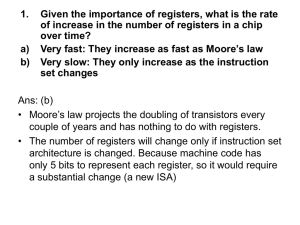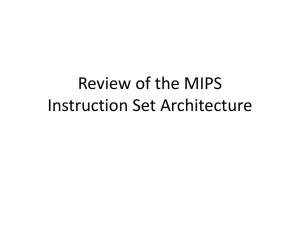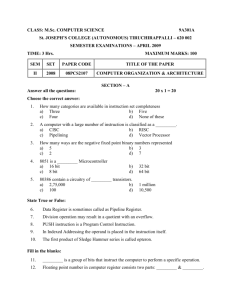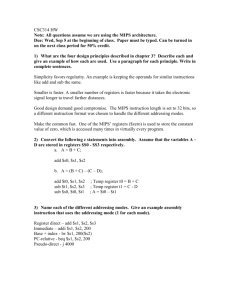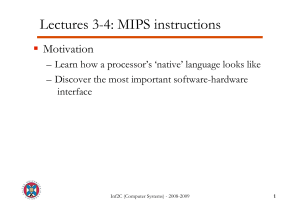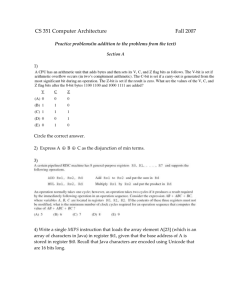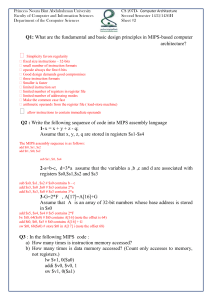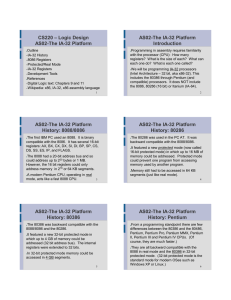CSE 431. Computer Architecture
advertisement
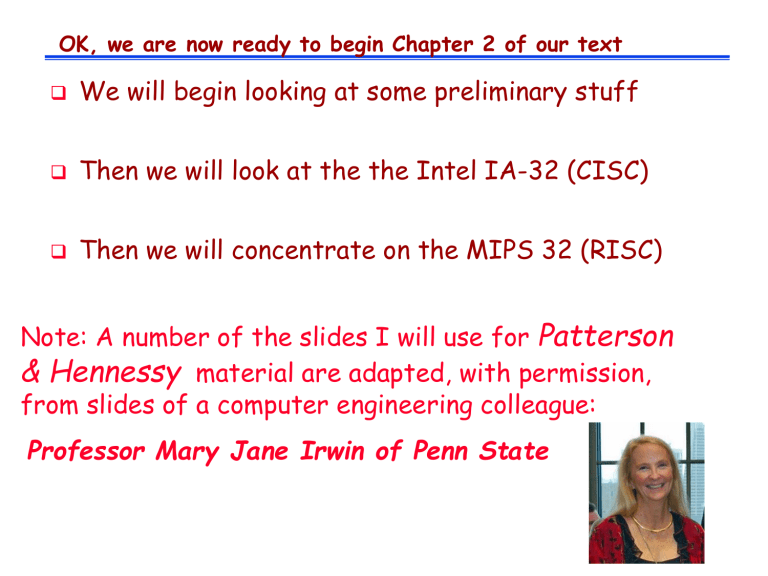
OK, we are now ready to begin Chapter 2 of our text We will begin looking at some preliminary stuff Then we will look at the the Intel IA-32 (CISC) Then we will concentrate on the MIPS 32 (RISC) Note: A number of the slides I will use for Patterson & Hennessy material are adapted, with permission, from slides of a computer engineering colleague: Professor Mary Jane Irwin of Penn State Where is the Market? Millions of Computers 1200 1122 1000 892 Embedded Desktop Servers 862 800 600 488 400 290 200 0 93 3 1998 114 3 1999 135 4 2000 129 4 2001 131 5 2002 ISA Type Sales Other SPARC Hitachi SH PowerPC Motorola 68K MIPS IA-32 ARM 1400 Millions of Processor 1200 1000 800 600 400 200 0 1998 1999 2000 2001 2002 Moore’s Law In 1965, Gordon Moore predicted that the number of transistors that can be integrated on a die would double every 18 to 24 months (i.e., grow exponentially with time). The million transistor/chip barrier was crossed in the 1980’s. 2300 transistors, 1 MHz clock (Intel 4004) - 1971 16 Million transistors (Ultra Sparc III) 42 Million transistors, 2 GHz clock (Intel Xeon) – 2001 55 Million transistors, 3 GHz, 130nm technology, 250mm2 die (Intel Pentium 4) - 2004 140 Million transistor (HP PA-8500) Processor Performance Increase Performance (SPEC Int) 10000 Intel Pentium 4/3000 DEC Alpha 21264A/667 DEC Alpha 21264/600 Intel Xeon/2000 1000 DEC Alpha 4/266 100 DEC AXP/500 DEC Alpha 5/500 DEC Alpha 5/300 IBM POWER 100 HP 9000/750 10 IBM RS6000 SUN-4/260 MIPS M2000 MIPS M/120 1 1987 1989 1991 1993 1995 Year 1997 1999 2001 2003 DRAM Capacity Growth 512M 256M 128M 1000000 64M Kbit capacity 100000 16M 10000 4M 1M 1000 256K 64K 100 16K 10 1976 1978 1980 1982 1984 1986 1988 1990 1992 1994 1996 1998 2000 2002 Year of introduction Computer Instruction Formats Three operand e.g. Opcode Source1, Source2, Destination Two operand e.g. Opcode Source1, Source2Destination One operand is used as Source & Destination One operand e.g. Opcode Source Result is deposited in an Accumulator The Intel IA 32 History of the IA-32 (Intel) 1971 – 4004 built by Intel as a calculator engine 1972 – 8008 introduced as an 8 bit computer 1974 – 8080 an 8 bit (16 address bit) enough power to build a computer around it – Altair 8800, IMSAI 8080, Osborne I (first portable computer 1981) 1976 – 8085 8080 with two interrupts 1978 – 8086 16 bit machine using enhanced 8080 instr & Reg 1980 - 8087 8086 floating pt co-processor 1981 - 8088 8 bit external data bus 1982 – 80186 & 80286 the later was the engine for the first IBM PC, added memory management to become a multiuser machine 1985 – 80386 32 bit machine with 32 bit address space 1989 – 80486 multiprogramming, pseudo GPR machine 1992 – Pentium & Pentium Pro (1995) higher performance 1997 - Added MMX media extentions 1999 – Added another 70 instructions Building a legacy nightmare ! 2001 – Added another 144 instructions 2003 - Amdahl architecture increased address space to 64 bits and breaks legacy chain 2004 – Intel adopts AMD64 architecture with slight addition IA-32 Registers IA-32 Registers IA-32 Flags Register Example IA-32 Instruction Format Sample IA-32 Instruction Formats Note: Instruction lengths vary from 1 to 17 bytes The MIPS 32 RISC - Reduced Instruction Set Computer RISC philosophy (keep it simple!) fixed instruction length(s) (one word?) load-store instruction sets (don’t do anything else) limited addressing modes limited operations MIPS, Sun SPARC, HP PA-RISC, IBM PowerPC, Intel (Compaq), Alpha, … Instruction sets are measured by how well compilers use them as opposed to how well assembly language programmers use them Design goals: speed, cost (design, fabrication, test, packaging), size, power consumption, reliability, memory space (embedded systems) MIPS R3000 Instruction Set Architecture (ISA) Registers Instruction Categories Computational Load/Store Jump and Branch Floating Point - R0 - R31 coprocessor PC HI Memory Management Special LO 3 Instruction Formats: all 32 bits wide OP rs rt OP rs rt OP rd sa immediate jump target funct R format I format J format MIPS Addressing Modes 1. Operand: Register addressing op rs rt rd funct Register word operand 2. Operand: Base addressing op rs rt offset Memory word or byte operand base register 3. Operand: Immediate addressing op rs rt operand 4. Instruction: PC-relative addressing op rs rt offset Memory branch destination instruction Program Counter (PC) 5. Instruction: Pseudo-direct addressing op Memory jump address || Program Counter (PC) jump destination instruction MIPS Register Convention Name Register Number $zero 0 $at 1 $v0 - $v1 2-3 $a0 - $a3 4-7 $t0 - $t7 8-15 $s0 - $s7 16-23 $t8 - $t9 24-25 $gp 28 $sp 29 $fp 30 $ra 31 Usage Preserve on call? constant 0 (hardware) n.a. reserved for assembler n.a. returned values no arguments yes temporaries no saved values yes temporaries no global pointer yes stack pointer yes frame pointer yes return addr (hardware) yes MIPS 32 “Card” MIPS Register File Register File Holds thirty-two 32-bit registers Two read ports and One write port Registers are Faster than main memory src1 addr src2 addr dst addr write data 32 bits 5 32 src1 data 5 5 32 locations 32 32 src2 - But register files with more locations write control are slower (e.g., a 64 word file could be as much as 50% slower than a 32 word file) - Read/write port increase impacts speed quadratically Easier for a compiler to use - e.g., (A*B) – (C*D) – (E*F) can do multiplies in any order vs. stack Can hold variables so that - code density improves (since register are named with fewer bits than a memory location) data MIPS Organization Processor Memory Register File src1 addr 5 src2 addr 5 dst addr write data 5 1…1100 src1 data 32 32 registers ($zero - $ra) read/write addr src2 32 data 32 32 32 bits branch offset 32 Fetch PC = PC+4 Exec 32 Add PC 32 Add 4 read data 32 32 32 write data 32 Decode 230 words 32 32 ALU 32 32 4 0 5 1 6 2 32 bits byte address (big Endian) 7 3 0…1100 0…1000 0…0100 0…0000 word address (binary)

